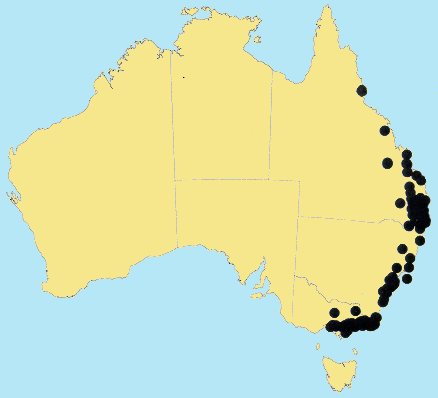Entolasia marginata (R.Br.) D. K.
Hughes. Bull. Misc.
Inform. 331
(1923).
Classification. (GPWG 2001) : Subfamily Panicoideae.
Paniceae.
Basionym and/or
Replacement Name: Panicum
marginatum R. Br., Prodr 190 (1810).
Type of Basionym or
Protologue Information: "Apud Portum Jackson, inclusis ripis aestuarii
Hunter's River vel Coal River.", Robert Brown or Banks, 1802–1805.
Key references
(books and floras): [1810]. R.Brown, Prodromus (190 as Panicum
marginatum), [1878] G.Bentham, Flora Australiensis 7 (485 as Panicum
marginatum), [1969] E.E.Henty, Manual Grasses New Guinea
(89), [2002] D.Sharp & B.K.Simon, AusGrass, Grasses of Australia,
[2008] S.W.L.Jacobs, R.D.B.Walley & D.J.B.Wheeler, Grasses of New South
Wales (244).
Illustrations:
[1984] N.T.Burbidge. rev. S.W.L.Jacobs, Australian Grasses (131), [2008] S.W.L.Jacobs, R.D.B.Whalley
& D.J.B.Wheeler, Grasses of New South Wales, 4th edn (244).
Habit.
Perennial. Rhizomes present, short. Culms geniculately ascending or decumbent
or sprawling, 20–60(–200) cm tall, wiry, 4–10 -noded. Mid-culm internodes
glabrous or hirsute. Mid-culm nodes glabrous or pubescent. Leaf-sheaths glabrous
on surface. Ligule a fringe of hairs, 0.5–1 mm long. Leaf-blades linear or
lanceolate, flat, 3–20 cm long, 2–15 mm wide. Leaf-blade surface smooth or
scabrous, glabrous or indumented.
Inflorescence.
Inflorescence compound, a panicle of racemes. Racemes 3–10, erect, 1–12 cm
long, bearing 2–12 fertile spikelets on each (secondary). Central inflorescence
axis 3–20 cm long.
Spikelets.
Spikelets pedicelled. Fertile spikelets 2-flowered, the lower floret barren
(rarely male), the upper fertile, comprising 1 basal sterile florets,
comprising 1 fertile floret(s), without rachilla extension, lanceolate or
elliptic, dorsally compressed, 2.4–3.8 mm long.
Glumes. Glumes
dissimilar, thinner than fertile lemma. Lower glume ovate, membranous, without
keels, 0–1 -nerved. Upper glume elliptic or ovate, 2.4–3.8 mm long, herbaceous,
without keels, 5 -nerved. Upper glume apex muticous or mucronate. Florets.
Basal sterile florets 1, barren, without significant palea. Lemma of lower
sterile floret 100 % of length of spikelet, herbaceous, 5 -nerved.
Fertile lemma 2–3 mm
long, without keel, 5 -nerved. Lemma surface indumented. Palea 2 -nerved.
Continental
Distribution: Tropical Asia, Australasia,
and Pacific.
Australian
Distribution: Queensland, New South Wales, Victoria.
Queensland:
Burnett, Darling Downs, Leichhardt, Moreton, North Kennedy, Port Curtis, South
Kennedy, Wide Bay. New South
Wales: North Coast, Central
Coast, South Coast,
Northern Tablelands, Central Tablelands, Southern Tablelands. Victoria:
East Gippsland, Eastern Highlands, Gippsland
Plain.
Notes. Similar to E. minutifolia by having flat leaf blades, as opposed to E. stricta and E. whiteana with incurved to involute leaf blades. Differs from E. minutifolia by having leaf blades more than 3 cm long and soft in texture
In tropical heaths,
tropical and subtropical rain forests, tropical and subtropical wet sclerophyll
forests, dry sclerophyll forests, Brigalow forests, tropical and subtropical
sub-humid woodlands, and temperate sub-humid woodlands. Flowers throughout the
year.


